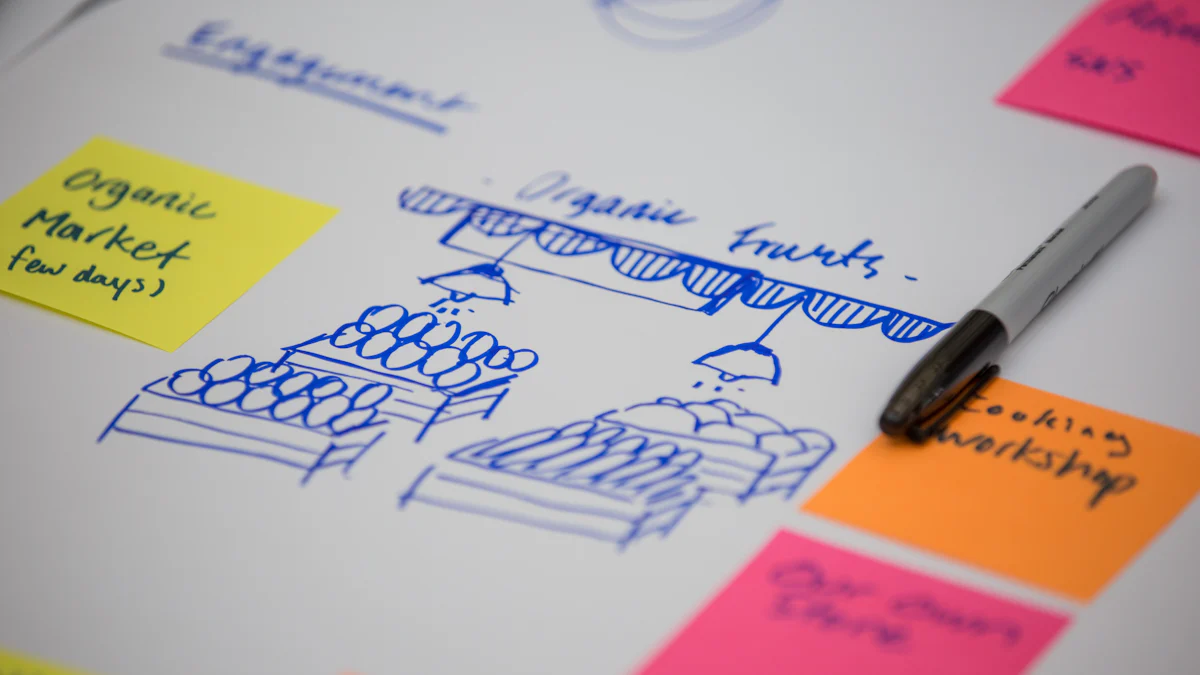

Customer Journey Orchestration
Sean, Industry Editor
Sep 30, 2024

Customer Journey Orchestration is all about understanding your customers' behavior across different channels and using that data to create personalized experiences. In today's fast-paced business world, this approach has become crucial. Companies that focus on customer experience can see an 80% increase in revenue and lower operational costs. By effectively orchestrating the customer journey, you can enhance customer satisfaction and loyalty. AI plays a significant role here, allowing you to gather data on a massive scale, from demographics to browsing habits, ensuring you meet your customers' needs at every step.
Understanding Customer Journey Orchestration
Definition and Scope of Customer Journey Orchestration
Customer Journey Orchestration is about creating seamless experiences for your customers. You gather data from various channels to understand their behavior and tailor interactions. This approach ensures that every touchpoint feels personal and relevant.
Key Elements
To orchestrate effectively, focus on these key elements:
-
Data Collection: Gather information from every interaction.
-
Real-Time Analysis: Use analytics to understand customer needs instantly.
-
Personalization: Tailor experiences based on insights.
Scope Across Industries
Customer Journey Orchestration isn't limited to one sector. Retail, healthcare, and finance all benefit. Each industry uses orchestration to enhance customer satisfaction and engagement. For instance, retail leverages AI tools to personalize shopping experiences, while healthcare focuses on patient interactions.
Historical Context of Customer Journey Orchestration
Understanding the history helps you see why orchestration matters today.
Evolution of Customer Experience
Customer experience has evolved dramatically. In the past, businesses focused on transactions. Now, they prioritize relationships. This shift means you need to understand and anticipate customer needs at every stage.
Technological Advancements
Technology plays a huge role in this evolution. AI and analytics have transformed how you interact with customers. These tools allow you to predict behaviors and deliver personalized content. As conversational commerce grows, orchestrating consistent conversations across channels becomes essential.
"The customer journey is no longer linear; it's a web of interactions."
By embracing these advancements, you ensure that your approach remains flexible and responsive to changing behaviors and market trends.
Components of Customer Journey Orchestration
Data Integration
Data integration forms the backbone of Customer Journey Orchestration. You need to gather and unify data from various sources to create a seamless experience.
Sources of Customer Data
You can collect customer data from multiple touchpoints. These include:
-
Websites: Track browsing behavior and interactions.
-
Social Media: Understand engagement and preferences.
-
In-Store Visits: Capture purchase history and feedback.
-
Customer Support: Analyze inquiries and resolutions.
By consolidating this data, you gain a comprehensive view of your customers.
Importance of Real-Time Data
Real-time data is crucial for effective orchestration. It allows you to respond instantly to customer needs. Imagine a customer browsing your website. With real-time insights, you can offer personalized recommendations or support, enhancing their experience. This immediacy builds trust and satisfaction.
Personalization
Personalization is at the heart of Customer Journey Orchestration. It transforms generic interactions into meaningful experiences.
Tailoring Experiences
Tailoring experiences means customizing interactions based on individual preferences. You can achieve this by:
-
Segmenting Audiences: Group customers with similar behaviors.
-
Personalized Content: Deliver messages that resonate with each segment.
-
Dynamic Offers: Adjust promotions based on real-time data.
These strategies ensure that every interaction feels unique and relevant.
Tools and Technologies
To personalize effectively, leverage advanced tools and technologies:
-
AI and Machine Learning: Predict customer behavior and preferences.
-
Automation Platforms: Streamline communication across channels.
-
Predictive Analytics: Anticipate future needs and tailor interactions accordingly.
These technologies empower you to create proactive and engaging customer journeys.
"Omnichannel orchestration helps leverage customer data to personalize interactions."
By integrating these components, you ensure that your Customer Journey Orchestration strategy is robust and effective. This approach not only enhances customer satisfaction but also positions your business ahead of the competition.
Benefits of Customer Journey Orchestration

Enhanced Customer Experience
Consistency Across Channels
You want your customers to feel valued and understood, no matter where they interact with your brand. Customer Journey Orchestration ensures that every touchpoint delivers a consistent experience. Whether they're browsing your website, visiting your store, or chatting with support, the experience remains seamless. This consistency builds trust and makes your brand memorable.
Increased Customer Satisfaction
When you tailor experiences to individual preferences, satisfaction naturally increases. By using strategic data like demographics and browsing behavior, you can predict what your customers need. This proactive approach means you can offer solutions before they even ask. Happy customers are loyal customers, and loyalty translates into long-term success.
Business Outcomes
Improved ROI
Investing in Customer Journey Orchestration pays off. By aligning your teams with the same data and automating repetitive tasks, you streamline operations. This efficiency reduces costs and boosts revenue. When you understand your customers' journeys, you can target them more effectively, leading to higher conversion rates and a better return on investment.
Competitive Advantage
In today's market, standing out is crucial. Customer Journey Orchestration gives you that edge. By mapping experiences to specific customer preferences, you create unique interactions that competitors can't match. This personalized approach not only attracts new customers but also retains existing ones. Staying ahead of trends and continuously adapting ensures your business remains a leader in the industry.
"The key to success lies in understanding and anticipating customer needs."
By embracing Customer Journey Orchestration, you position your business to thrive in a competitive landscape.
Challenges in Implementing Customer Journey Orchestration
Implementing Customer Journey Orchestration can be a game-changer for your business, but it comes with its own set of challenges. Let's dive into some of the hurdles you might face and how to tackle them.
Data Privacy Concerns
Data privacy is a hot topic these days. Customers want personalized experiences, but they also want to know their information is safe. You need to strike a balance between using data effectively and respecting privacy.
Compliance with Regulations
Navigating the maze of data privacy regulations can feel overwhelming. Laws like the General Data Protection Regulation (GDPR) and the California Consumer Privacy Act (CCPA) set strict guidelines on how you can collect and use customer data. To stay compliant, you must understand these regulations and implement them in your orchestration strategy. Regular audits and updates to your data policies can help you stay on the right side of the law.
Building Trust with Customers
Trust is the foundation of any successful customer relationship. You need to be transparent about how you use customer data. Clear communication about your data practices can build trust. Let your customers know what data you collect and how you use it to enhance their experience. When customers feel confident that their data is secure, they're more likely to engage with your brand.
Technological Barriers
Technology is a double-edged sword. It offers incredible opportunities for orchestration, but it also presents challenges.
Integration Issues
Integrating various systems and platforms can be tricky. You might have data scattered across different channels, making it hard to create a unified view of the customer journey. To overcome this, invest in robust integration tools that can seamlessly connect your data sources. This will help you gather insights and deliver a cohesive experience.
Cost and Resource Allocation
Implementing Customer Journey Orchestration requires resources. You need the right technology, skilled personnel, and time to make it work. Budget constraints can be a significant barrier. To manage costs, prioritize the most impactful areas of orchestration. Start small, measure results, and scale up as you see success. Efficient resource allocation ensures you get the most bang for your buck.
"The key to overcoming these challenges lies in strategic planning and continuous adaptation."
By addressing these challenges head-on, you can unlock the full potential of Customer Journey Orchestration and create memorable experiences for your customers.
Strategies for Effective Customer Journey Orchestration
To make the most of Customer Journey Orchestration, you need to adopt effective strategies. These strategies help you create a seamless and personalized experience for your customers.
Cross-Department Collaboration
Aligning Goals
You can't achieve successful orchestration without aligning goals across departments. Each team, from marketing to customer service, should work towards a common objective. This alignment ensures that everyone understands the customer journey and contributes to a unified experience. Start by setting clear goals and communicating them to all departments. Regular meetings can help keep everyone on the same page.
Sharing Insights
Sharing insights between departments is crucial. When teams share data and observations, they gain a comprehensive view of the customer journey. Encourage open communication and create platforms where teams can easily exchange information. This collaboration leads to better decision-making and more personalized customer interactions. By pooling insights, you can identify trends and adjust strategies to meet customer needs effectively.
Leveraging Technology
AI and Machine Learning
AI and machine learning play a vital role in Customer Journey Orchestration. These technologies analyze vast amounts of data to predict customer behavior. By understanding patterns, you can tailor experiences to individual preferences. Implement AI tools to automate data analysis and provide real-time insights. This approach allows you to anticipate customer needs and deliver personalized content at the right moment.
Automation Tools
Automation tools streamline the orchestration process. They handle repetitive tasks, freeing up your team to focus on strategic initiatives. Use automation to manage customer interactions across channels. This ensures consistency and efficiency in your communication. Automation also helps in tracking customer journeys, allowing you to make data-driven decisions. By leveraging these tools, you enhance the overall customer experience and improve operational efficiency.
"Technology is not just a tool; it can transform how you connect with your customers."
By adopting these strategies, you ensure that your Customer Journey Orchestration efforts are effective and impactful. Collaboration and technology work hand in hand to create a seamless and personalized experience for your customers.
Case Studies of Customer Journey Orchestration
Exploring real-world examples can help you understand how Customer Journey Orchestration works in practice. Let's dive into two successful implementations.
Successful Implementations
Amazon
Amazon excels at Customer Journey Orchestration by offering personalized product recommendations. When you browse their site, you'll notice suggestions tailored to your interests. This approach increases engagement and boosts conversion rates. Amazon uses data from your browsing history and previous purchases to create a seamless shopping experience. By doing so, they ensure that every interaction feels relevant and personal.
Netflix
Netflix takes personalization to another level with content suggestions based on your viewing history. When you log in, you'll see recommendations that match your preferences. This strategy reduces churn and keeps you engaged. Netflix analyzes your past behavior to predict what you might enjoy next. This proactive approach keeps you coming back for more, enhancing user satisfaction and loyalty.
Lessons Learned
Key Takeaways
-
Personalization is Key: Both Amazon and Netflix show that tailoring experiences to individual preferences leads to higher engagement.
-
Data Utilization: Leveraging data effectively allows you to predict customer needs and deliver relevant content.
-
Consistency Across Channels: Ensuring a seamless experience across different platforms builds trust and loyalty.
Common Pitfalls
-
Over-Reliance on Technology: While technology is crucial, don't forget the human touch. Balance automation with personal interactions.
-
Data Privacy Concerns: Always prioritize customer privacy. Be transparent about how you use data to build trust.
-
Integration Challenges: Ensure that your systems work together smoothly to provide a unified customer experience.
By learning from these examples, you can apply similar strategies to enhance your own Customer Journey Orchestration efforts. Focus on personalization, data-driven insights, and maintaining consistency to create memorable experiences for your customers.
Future Trends in Customer Journey Orchestration

As you look to the future of Customer Journey Orchestration, you'll notice some exciting trends shaping the landscape. These trends not only enhance how you interact with customers but also redefine their expectations.
Emerging Technologies
Predictive Analytics
Predictive analytics is becoming a game-changer in customer journey orchestration. By analyzing past behaviors, you can anticipate what your customers might do next. This foresight allows you to tailor experiences that meet their needs before they even express them. Imagine knowing which products a customer might be interested in based on their previous purchases. You can offer personalized recommendations that feel almost magical. This proactive approach not only enhances satisfaction but also boosts loyalty.
IoT Integration
The Internet of Things (IoT) is another trend that's transforming customer interactions. With IoT, you can gather data from various connected devices, providing a more comprehensive view of your customers' lives. For instance, smart home devices can offer insights into daily routines, helping you create more relevant and timely interactions. By integrating IoT data, you ensure that your customer journey orchestration is not just reactive but also anticipatory, creating seamless experiences across all touchpoints.
Evolving Customer Expectations
Demand for Personalization
Today's customers expect personalization at every step of their journey. They want experiences that resonate with their unique preferences and needs. By leveraging advanced technologies like AI and machine learning, you can deliver highly personalized content that speaks directly to each individual. This level of customization makes customers feel valued and understood, fostering deeper connections with your brand.
Omnichannel Experiences
Customers now interact with brands across multiple channels, from websites to social media to in-store visits. They expect a consistent experience no matter where they engage. By orchestrating these interactions seamlessly, you ensure that your brand message remains cohesive and compelling. Whether a customer starts their journey online and completes it in-store, or vice versa, the transition should feel effortless. This omnichannel approach not only meets customer expectations but also enhances their overall experience.
"In this dynamic and competitive landscape, the businesses that weave the tapestry of their customer journey with the threads of AI will not only survive but thrive."
By embracing these future trends, you position your business to not just meet but exceed customer expectations. The integration of emerging technologies and the focus on evolving customer needs ensure that your customer journey orchestration remains at the forefront of innovation.
Customer Journey Orchestration is crucial for businesses today. It helps you understand your customers better and predict their needs. By adopting orchestration strategies, you can enhance customer experiences and boost satisfaction. As customer journeys become more complex, you'll need to embrace new service channels and innovative AI technologies. This approach not only improves interactions but also positions your business for future opportunities. Remember, strategic data collection and identifying key touchpoints are essential. Stay ahead by investing in automation and continuously adapting to evolving customer expectations.
FAQ
Customer Journey Orchestration involves understanding customer behavior across various channels and using that data to create personalized experiences. It ensures that every interaction feels relevant and seamless, enhancing customer satisfaction and loyalty.
It helps businesses align their customer-facing teams, automate tasks, and map experiences to customer preferences. This strategic approach not only boosts customer satisfaction but also improves business outcomes like ROI and competitive advantage.
AI plays a crucial role by enabling businesses to collect data at scale and understand customer preferences. It provides actionable insights that help tailor experiences to individual needs, making interactions more meaningful and effective.
Successful orchestration relies on strategic data collection, identifying key touchpoints, and leveraging orchestration tools. These components work together to create a cohesive and personalized customer journey.
Common challenges include data privacy concerns, technological barriers, and integration issues. Addressing these challenges requires careful planning, compliance with regulations, and investment in robust technology solutions.
Businesses can overcome these challenges by ensuring compliance with data privacy regulations, building trust with customers, and using advanced integration tools. Strategic planning and continuous adaptation are key to unlocking the full potential of Customer Journey Orchestration.
Emerging technologies like predictive analytics and IoT integration are shaping the future of orchestration. Additionally, evolving customer expectations for personalization and omnichannel experiences will drive innovation in this field.
Continue Reading About Customer Journey Orchestration
Customer Data Integration: A Comprehensive Guide
Master customer data integration to enhance business operations by combining data from multiple sources for a comprehensive customer view.
Howard
Sep 07, 2024
Augmented Analytics: Unlock the Core Concepts & Benefits!
Discover augmented analytics—where AI and ML automate data prep and insights, revolutionizing decision-making for smarter, faster business strategies!
Lewis
Mar 04, 2025
Which Data Analysis Projects Work Best for Beginners?
Ready to shine in 2025? Discover easy data analysis projects to boost your portfolio, learn data cleaning, visualization, and tackle real-world challenges!
Lewis
Mar 10, 2025
Best Data Integration Platforms to Use in 2025
Explore the best data integration platforms for 2025, including cloud-based, on-premises, and hybrid solutions. Learn about key features, benefits, and top players.
Howard
Jun 20, 2024
Best Data Integration Vendors for Seamless Workflows
Discover the top 20 data integration vendors of 2025 for seamless workflows. Compare tools like Talend, AWS Glue, and Fivetran to optimize your data processes.
Howard
Jan 22, 2025
Covers Dashboard: Find Your Perfect Match
Choose the perfect covers dashboard to protect and style your car, enhancing its interior and resale value with the right material and fit.
Lewis
Nov 05, 2024


